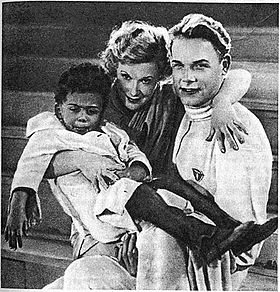The 1936 Soviet film “Circus” follows Marion Dixon, an American woman who flees to the USSR after giving birth to a biracial child. Once in Russia, Marion becomes a popular circus artist and falls in love with a fellow performer, Petrovich Martynov. The film was laced with comical antics and melodramatic, intertwining romances, but the end blatantly revealed underlying political messages concerning race and nationality, and the power of the Soviet government to inspire and mobilize its population.
The climax of the film occurred when, in a fit of jealousy, the nefarious theatrical agent Franz von Kneishitz interrupted Marion and Petrovich’s attempt at a record breaking stunt. Kneishitz had grabbed Marion’s son and held him up before the crowd declaring her a criminal for being the “mistress of a negro.” ((Circus, Grigori Aleksandrov and Isidor Simkov, 1936.)) To his shock, Kneishitz is met with laughter from the crowd who wrestle the child from his grasp and proceed to cradle him until his mother can be found. After an array of people sing to the child, he is returned to Dixon and the manager of the circus proclaimed “in our country we love absolutely all kids, you may have a kid of any color,” establishing the USSR as morally superior to places like the United States. ((Circus, Grigori Aleksandrov and Isidor Simkov, 1936.)) The scene of racial harmony directly related to the question of nationality that plagued Soviet Russia throughout its existence. A message of tolerance towards those of different ethnicities reinforced the Leninist policy of encouraging ethnic groups to maintain their own culture and customs while being actively socialist components of larger Soviet Russia.
After displaying Soviet supremacy in morality and tolerance, “Circus” displayed the unity and pride of the Soviet citizenry through a closing scene comprised of a pristine march. The parade was headed by Dixon, Martynov, and the circus manager triumphantly holding up Dixon’s son. Flags adorned with portraits of Lenin flew among the immaculate lines of marching Soviets. At the front of one regiment, an orthodox-style icon displaying Stalin’s face was proudly shown, constituting a replacement to the previously dominant Eastern Orthodox faith. The demonstration of Soviet harmony and calculated consistency glorified the ability of the state to mobilize its population, and caused Marion to “see” that the Soviet Union was the paramount nation. ((Circus, Grigori Aleksandrov and Isidor Simkov, 1936.)) When looking at this film in the context of the arguably chaotic Soviet Union of the 1930s, it is intriguing to consider the aims of the film’s creator and how Soviet audiences may have understood the messages presented to them.
Picture from: https://upload.wikimedia.org/wikipedia/en/thumb/c/c5/Orlova,_Patterson_and_Stolyarov.jpg/280px-Orlova,_Patterson_and_Stolyarov.jpg


I also wonder how Soviet audiences understood the message of the movie. The ending is clearly propaganda. However, considering that this may be the first time many of the still illiterate citizens are being exposed to this kind of propaganda, the symbols and messages may have flown over their heads. I’m also interested in how the Soviet population felt about this movie as well as the government’s reaction or even involvement in the messages delivered.